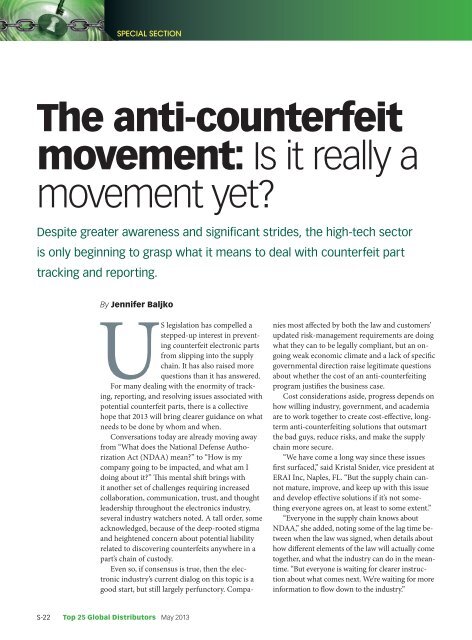Special SectionThe anti-counterfeitmovement: Is it really amovement yet?Despite greater awareness and significant strides, the high-tech sectoris only beginning to grasp what it means to deal with counterfeit parttracking and reporting.By Jennifer BaljkoUS legislation has compelled astepped-up interest in preventingcounterfeit electronic partsfrom slipping into the supplychain. It has also raised morequestions than it has answered.For many dealing with the enormity of tracking,reporting, and resolving issues associated withpotential counterfeit parts, there is a collectivehope that <strong>2013</strong> will bring clearer guidance on whatneeds to be done by whom and when.Conversations today are already moving awayfrom “What does the National Defense AuthorizationAct (NDAA) mean?” to “How is mycompany going to be impacted, and what am Idoing about it?” This mental shift brings withit another set of challenges requiring increasedcollaboration, communication, trust, and thoughtleadership throughout the electronics industry,several industry watchers noted. A tall order, someacknowledged, because of the deep-rooted stigmaand heightened concern about potential liabilityrelated to discovering counterfeits anywhere in apart’s chain of custody.Even so, if consensus is true, then the electronicindustry’s current dialog on this topic is agood start, but still largely perfunctory. Companiesmost affected by both the law and customers’updated risk-management requirements are doingwhat they can to be legally compliant, but an ongoingweak economic climate and a lack of specificgovernmental direction raise legitimate questionsabout whether the cost of an anti-counterfeitingprogram justifies the business case.Cost considerations aside, progress depends onhow willing industry, government, and academiaare to work together to create cost-effective, longtermanti-counterfeiting solutions that outsmartthe bad guys, reduce risks, and make the supplychain more secure.“We have come a long way since these issuesfirst surfaced,” said Kristal Snider, vice president atERAI Inc, Naples, FL. “But the supply chain cannotmature, improve, and keep up with this issueand develop effective solutions if it’s not somethingeveryone agrees on, at least to some extent.”“Everyone in the supply chain knows aboutNDAA,” she added, noting some of the lag time betweenwhen the law was signed, when details abouthow different elements of the law will actually cometogether, and what the industry can do in the meantime.“But everyone is waiting for clearer instructionabout what comes next. We’re waiting for moreinformation to flow down to the industry.”S-22 Top 25 Global Distributors <strong>May</strong> <strong>2013</strong>
Until that happens, the industry’s not standing still.Here’s a snapshot of what’s happening today and what elseneeds to be done to keep the anti-counterfeit movementmoving ahead.NDAA’s impact todayBy now, any company touching the US defense and aerospaceindustry knows about the NDAA and its notoriousSection 818. The law, brought into force in 2012 andupdated this year, holds defense contractors accountablefor detecting suspect or counterfeit electronic parts andpaying for remediation and rework if suspect or counterfeitparts show up in their products. NDAA is thegovernment’s way of addressing the harm being done byworldwide counterfeiting and piracy, the magnitude ofwhich—when calculated broadly and beyond electronics—is estimated to be “well over” $600billion, according to the InternationalChamber of Commerce.With the law in place, mostcompanies in this supply-chain segmentare likely already having deepertalks about risk mitigation, warrantycontracts, and test and inspectionprocesses ensuring part quality andauthenticity. Since some OEM somewhereis going to be accountable tothe Department of Defense, it’s onlya matter of time before they work through their approvedsupplier list and call up with questions about how parts aresourced, where they were procured, how long they havebeen in inventory, and how trustworthy is that source ofsupply.The lead-up to the legislation’s approval and the yearsince have also ushered in a new wave of industry conferences,training programs, working committees, and standards.Initially, these aimed to create awareness, but nowthe focus scopes more toward due diligence.That push is keeping Carlo S Abesamis, quality engineerfor the Procurement Quality Assurance group atNASA’s Jet Propulsion Laboratory (JPL), busy. Abesamis,whose main responsibility is to audit the organization’selectronics suppliers, also manages JPL’s CounterfeitAwareness Training program, which started in 20<strong>08</strong> beforethe mainstream was thinking about this and providesinstruction to other NASA groups and external organizationssuch as the US Department of Justice and Customsand Border Protection (CBP).by now, anycompany touchingthe us defense andaerospace industryknows about thendaa’s section 818.“Shortly after I was hired, one of the tasks I was askedto work on was counterfeit parts training. Even back then,we have always had support from top management atheadquarters to do this kind of outreach and awarenessbuilding,” Abesamis said. “When we first started theseprograms, it was about creating awareness. Today peopleknow about the problem, and now they want more indepthinformation about it.”JPL uses a modular training approach, walking peoplethrough the basics and then going into topics such as riskmitigationevaluations and establishing supplier requirementsfor obsolete parts. Another module being developedwill focus on part inspection, from visual componentinspection up to running parts through state-of-the-arttest and X-ray equipment, he said.Other companies—namely independent distributorsthat have taken the most heat sofar because of their open-marketprocurement strategies and theperceived associated risk of bringingsuspect parts to the supply chain—are also proactively trying to nipcounterfeit issues in the bud, despitethe high cost of doing so. The toptierindependent distributors, for instance,are investing in new test andX-ray machines, hiring and trainingmore inspectors, undergoing rigorousstandards-adoption measures, and doing all they canto prove due diligence, said Debra Eggeman, executivedirector of the Independent Distributors of ElectronicsAssociation in Buena Park, CA.According to Eggeman, “Many of our members havebeen flushing out their risk-mitigation strategies and arein the process of adopting new standards,” such as IDEA-QMS-9090 and SAE’s AS5553 and AS6<strong>08</strong>1, which addresspart quality and counterfeit-detection processes. “They arealso constantly being challenged to upgrade equipment,and many independent distributors are making significantcapital equipment investments. Some are installing theirfirst X-ray machines; others are looking to buy new equipmentwith more sophisticated software algorithms that canbetter detect inconsistencies or process more parts. As theybecome more educated about this, they also recognize thatthey need more people to work on this. These aren’t thekinds of people you can hire from Monster.com.”A harder task, though, isn’t just detecting counterfeitsas new parts arrive at the warehouse. It’s knowing what’s in<strong>May</strong> <strong>2013</strong> Top 25 Global Distributors S-23






![[270].pdf 37407KB Sep 02 2010 09:55:57 AM - ElectronicsAndBooks](https://img.yumpu.com/50350834/1/185x260/270pdf-37407kb-sep-02-2010-095557-am-electronicsandbooks.jpg?quality=85)
![draaien, A Viruly 1935 OCR c20130324 [320]. - ElectronicsAndBooks](https://img.yumpu.com/49957773/1/190x252/draaien-a-viruly-1935-ocr-c20130324-320-electronicsandbooks.jpg?quality=85)



![20051110 c20051031 [105].pdf 35001KB Feb 18 2009 08:46:32 PM](https://img.yumpu.com/48687202/1/190x253/20051110-c20051031-105pdf-35001kb-feb-18-2009-084632-pm.jpg?quality=85)




